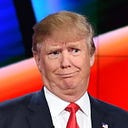Day 440: Trump Gets His Trade War with China, Markets Continue Plummeting
Trying to flip-flop and blame predecessors, Trump can’t escape the numbers.
Donald Trump’s economic policy has been one of impulsiveness. He has ranted about trade deficits and suddenly announced tariffs on a number of imports. He proclaimed that “trade wars are good, and easy to win.”
Despite his concerns over billions of dollars in trade deficits, Trump’s big plan was to have them reduce it by a mere $1 billion.
Now, less than 24 hours after Trump announced Chinese goods he would like to slap tariffs on, China reacted and announced tariffs of their own.
China announced additional tariffs on 106 U.S. products on Wednesday, in a move likely to heighten global concerns of a tit-for-tat trade war between the world’s biggest economies.
The effective start date for the new charges was not announced, though China’s Ministry of Commerce said the tariffs are designed to target up to $50 billion of U.S. products annually.
The 25 percent levy on U.S. imports includes products such as soybeans, cars and whiskey, Beijing said.
The markets have responded to Trump’s tariff talk. The Dow Jones Industrial Average is down 1,600 points in less than four weeks, and down nearly 3,000 points since its January 26 high. The S&P 500 and Nasdaq Composite are both down 10 percent in the same time frame.
Markets are usually influenced by long-term economic outlook and changes to interest rates. However, they can react to economic policies announced by presidents as well, and that appears to be happening as Trump’s desire for a trade war move forward. As the rhetoric has turned into action, other countries, like China, are setting in motion their own plans to tax American goods, which is going to drive down exports across the board. As we explained on Day 407, Americans will certainly suffer.
In the U.S., assuming steady demand, a reduction in imported goods will causes prices to rise for American consumers. Meanwhile, the goods that are imported and taxed at higher rates will have those costs largely passed on to the end-buyer. These are basic, bedrock macroeconomic principles that Trump thinks are easy to defeat on a worldwide scale.
Trump loves to tout market gains, even if they were proceeded by a large selloff. As the markets continue a downward trend, Trump can’t do that. Now he’s proclaiming that the U.S. is not actually in a trade war, but blaming his predecessors, despite the market not seeing such wild vacillations in nearly a decade.
However, facts don’t lie: under Trump, the trade deficit has risen by 12.1 percent from 2016, including a record high $375 billion from China.
Markets aren’t reacting to a trade deficit — which generally indicate a strong economy — but Trump’s impending trade war.
440 days in, 1022 to go
Follow us on Twitter at @TrumpTimer
